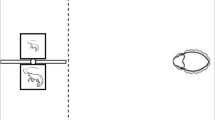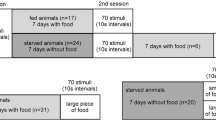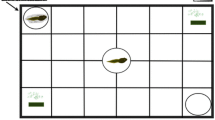Abstract
Moving shadows signify imminent threat to foraging juvenile crayfish, and the animals respond with one of two discrete anti-predatory behaviors: They either freeze in place or rapidly flex their tails, which quickly propels them away from the approaching danger signal. Although a freeze might be the more risky choice, it keeps the animal near the expected food reward, while a tail-flip is effective in avoiding the shadow, but puts critical distance between the animal and its next meal. We manipulated the satiation level of juvenile crayfish to determine whether their behavioral choices are affected by internal energy states. When facing the same visual danger signal, animals fed to satiation produced more tail-flips and fewer freezes than unfed animals, indicating that intrinsic physiological conditions shape value-based behavioral decisions. Escape tail-flip latencies, however, were unaffected by satiation level, and an increase in food quality only produced a minor behavioral shift toward more freezing in both fed and unfed animals. Thus, satiation level appears to be the dominant factor in regulating decision making and behavioral choices of crayfish.





Similar content being viewed by others
References
Buskey EJ, Hartline DK (2003) High-speed video analysis of the escape responses of the copepod Acartia tonsa to shadows. Biol Bull 204:28–37
Camerer C, Loewenstein G, Prelac D (2005) Neuroeconomics: How neuroscience can inform economics. J Econ Lit 43:9–64
Card G, Dickinson MH (2008) Visually mediated motor planning in the escape response of Drosophila. Curr Biol 18:1300–1307
Crossley M, Staras K, Kemenes G (2016) A two-neuron system for adaptive goal-directed decision-making in Lymnaea. Nat Commun 7
Davis KM, Huber R (2007) Activity patterns, behavioural repertoires, and agonistic interactions of crayfish: a non-manipulative field study. Behaviour 144:229–247
De Franceschi G, Vivattanasarn T, Saleem AB, Solomon SG (2016) Vision guides selection of freeze or flight defense strategies in mice. Curr Biol 26:2150–2154
Dickinson KJ, Wainwright ML, Mozzachiodi R (2015) Change in excitability of a putative decision-making neuron in Aplysia serves as a mechanism in the decision not to feed following food satiation. Behav Brain Res 281:131–136
Doya K (2008) Modulators of decision-making. Nat Neurosci 11:410–416
Edwards DH, Heitler WJ, Krasne FB (1999) Fifty years of a command neuron: the neurobiology of escape behavior in the crayfish. Trends Neurosci 22:153–161
Eilam D (2005) Die hard: a blend of freezing and fleeing as a dynamic defense—implications for the control of defensive behavior. Neurosci Biobehav Rev 29:1181–1191
Englund G, Krupa JJ (2000) Habitat use by crayfish in stream pools: influence of predators, depth and body size. Freshwater Biol 43:75–83
Fotowat H, Gabbiani F (2007) Relationship between the phases of sensory and motor activity during a looming-evoked multistage escape behavior. J Neurosci 27:10047–10059
Gaudry Q, Kristan WB Jr (2012) Decision points: the factors influencing the decision to feed in the medicinal leech. Front Neurosci 6(:):101
Gibson WT, Gonzalez CR, Fernandez C et al (2015) Behavioral responses to a repetitive visual threat stimulus express a persistent state of defensive arousal in Drosophila. Curr Biol 25:1401–1415
Glimcher PW, Rustichini A (2004) Neuroeconomics: the consilience of brain and decision. Science 306:447–452
Harrison Y, Horne JA (2000) The impact of sleep deprivation on decision making: a review. J Exp Psychol 6:236–249
Heekeren S, Marrett P, Bandettini A, Ungerleider LG (2004) A general mechanism for perceptual decision-making in the human brain. Nature 431:859–862
Hemmi JM, Tomsic D (2012) The neuroethology of escape in crabs: from sensory ecology to neurons and back. Curr Opin Neurobiol 22:194–200
Herberholz J, Marquart GD (2012) Decision making and behavioral choice during predator avoidance. Front Neurosci 6:125
Herberholz J, Issa FA, Edwards DH (2001) Patterns of neural circuit activation and behavior during dominance hierarchy formation in freely behaving crayfish. J Neurosci 21:2759–2767
Herberholz J, Sen MM, Edwards DH (2004) Escape behavior and escape circuit activation in juvenile crayfish during prey–predator interactions. J Exp Biol 207:1855–1863
Krasne FB, Edwards DH (2002) Modulation of the crayfish escape reflex—physiology and neuroethology. Integr Comp Biol 42:705–715
Krasne FB, Lee SC (1988) Response-dedicated trigger neurons as control points for behavioral actions: selective inhibition of lateral giant command neurons during feeding in crayfish. J Neurosci 8:3703–3712
Kristan WB (2008) Neuronal decision-making circuits. Curr Biol 18:928–932
Liden WH, Herberholz J (2008) Behavioral and neural responses of juvenile crayfish to moving shadows. J Exp Biol 211:1355–1361
Liden WH, Phillips ML, Herberholz J (2010) Neural control of behavioral choice in juvenile crayfish. Proc R Soc B 277:3493–3500
Lima SL (1998) Nonlethal effects in the ecology of predator-prey interactions. Bioscience 48:25–34
Lima SL, Dill LM (1990) Behavioral decisions made under the risk of predation: a review and prospectus. Can J Zool 68:619–640
Liu YC, Herberholz J (2010) Sensort activation and receptive field organization of the lateral giant escape neurons in crayfish. J Neurophysiol 104:675–684
Logothetis N (2008) What we can do and what we cannot do with fMRI. Nature 453:869–878
Marsh AA, Blair KS, Jones MM, Soliman N, Blair RJR (2009) Dominance and submission: the ventrolateral prefrontal cortex and responses to status cues. J Cog Neurosci 21:713–724
Oliva D, Medan V, Tomsic D (2007) Escape behavior and neuronal responses to looming stimuli in the crab Chasmagnathus granulatus (Decapoda: Grapsidae). J Exp Biol 210:865–880
Platt ML, Huettel SA (2008) Risky business: the neuroeconomics of decision making under uncertainty. Nat Neurosci 11:398–403
Rind FC, Santer RD, Wright GA (2008) Arousal facilitates collision avoidance mediated by a looming sensitive visual neuron in a flying locust. J Neurophysiol 100:670–680
Sanfey AG, Rilling JK, Aronson JA, Nystrom LE, Cohen JD (2003) The neural basis of economic decision-making in the ultimatum game. Science 300:1755–1758
Sanfey AG, Loewensteinb G, McClurec SM, Cohen JD (2006) Neuroeconomics: cross-currents in research on decision-making. Trends Cogn Sci 10:108–116
Santer RD, Rind FC, Simmons PJ (2012) Predator versus prey: locust looming-detector neuron and behavioural responses to stimuli representing attacking bird predators. PLoS One 7:e50146
Tablado Z, Tella JL, Sánchez-Zapata JA, Hiraldo F (2010) The paradox of the long-term positive effects of a North American crayfish on a European community of predators. Conserv Biol 24:1230–1238
Vu ET, Krasne FB (1993) Crayfish tonic inhibition: prolonged modulation of behavioral excitability by classical GABAergic inhibition. J Neurosci 13:4394–4402
Vu ET, Lee SC, Krasne FB (1993) The mechanism of tonic inhibition of crayfish escape behavior: distal inhibition and its functional significance. J Neurosci 13:4379–4393
Wine JJ, Krasne FB (1972) The organization of escape behavior in the crayfish. J Exp Biol 56:1–18
Wolff PJ, Taylor CA, Heske EJ, Schooley RL (2016) Predation risk for crayfish differs between drought and nondrought conditions. Freshw Sci 35:91–102
Yilmaz M, Meister M (2013) Rapid innate defensive responses of mice to looming visual stimuli. Curr Biol 23:2011–2015
Acknowledgements
This work was supported by a grant (IOS-0919845) from the National Science Foundation to J.H. We would like to thank Ms. Alexis Exum for her help with the manuscript.
Author information
Authors and Affiliations
Corresponding author
Rights and permissions
About this article
Cite this article
Schadegg, A.C., Herberholz, J. Satiation level affects anti-predatory decisions in foraging juvenile crayfish. J Comp Physiol A 203, 223–232 (2017). https://doi.org/10.1007/s00359-017-1158-8
Received:
Revised:
Accepted:
Published:
Issue Date:
DOI: https://doi.org/10.1007/s00359-017-1158-8




